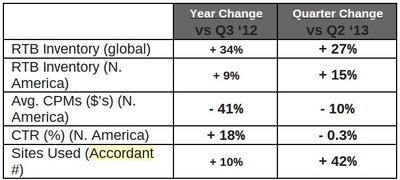As Real-Time Supply Expands, Prices Crash: Report Uncovers Rampant Net-Bot Fraud
- by Joe Mandese @mp_joemandese, October 23, 2013
While the supply of exchange-based impressions grew at a more moderate rate in North America, rising only 9% vs. the third quarter of 2012, that likely reflects the fact that North America is a more mature and developed real-time trading marketplace than developing media markets around the world.
Nonetheless, demand failed to keep pace with expanding supply, and the average cost of buying impressions through exchanges declined 41% in North American markets during the third quarter.
The report also includes Accordant's first-ever analysis of the impact of so-called “bot-net traffic” on the real-time bidding marketplace, which are impressions generated not by actual online users, but by machines. Working with online ad verification company White Ops Media, Accordant found that the RTB marketplace contains as much as 10.3% “fraudulent traffic,” or non-human audience impressions attributed to machines.
Accordant said that utilizing active monitoring and “blacklisting” sites enabling bots can “cut down on fraud nearly 85%.”
“The programmatic industry is shifting towards an emphasis on quality of media and breadth of marketing solutions,” stated Accordant Co Founder-CEO Art Muldoon, estimating that the marketplace now generates 50 billion ad impressions daily, and that advertisers are “understandably concerned about the quality of media where their ads appear.”
“This quarter, through controlled testing environments with White Ops Media, we found randomly sampled run-of-exchange inventory to contain just over 10% suspicious activity,” he explained.
Source: Accordant Media's "Real Time Media Buying Market Pulse"



Does anyone know where I can find the latest information on CTRs? Thank you. Bill
Can anyone dispute that the online advertising model is irrevocably broken; systemically collapsing under its own overinflated weight? And BTW, it has nothing to do with an expanding supply. In digital media, the supply is directly proportionate to audience demand -- in fact, the supply is subordinate to the demand in this case, because a pageview doesn't even exist until its creation is triggered by a conscious consumer choice. Lewis Carroll would love this stuff!
It would appear that, until the day that a net-bot actually buys something, using a valid credit card, counting anything other than real sales that can be proven to have been generated by an ad is inviting fraud. Then again, I'm just an amateur observer.
Mike, just a nuance on your comment. In the online world ad supply CAN lead demand. Take the following scenario. A consumer clicks on a page. One page view is generated. If that page carried a single ad then your statement is correct. However, I can't recall any site that runs just a single ad. For example, my favoured news site here in Sydney is currently running 13 (and that's not counting their cross-promotions of their other content and properties). If that page's ad content (or the page itself) is auto-refreshed then you double the problem. This is unlike a TV screen which when you buy and ad you get 100% of the screen and audio. Put simply, if revenues are low publishers can simply change their ad to content ratio and play around with refresh intervals ... bingo.
John, my point is that the only portion of the resulting pageview for which there is any demonstrated demand whatsoever is the uninterrupted delivery of the content choice that created that pageview in the first place. 13 ad positions festooning the fringes merely produces 13 worthless media buys, not 13 ways to catch the eye of an otherwise engaged consumer. What part of .05% CTRs, 40+% pre-roll abandon rates, and ten-cent CPMs don't we get?
Agreed Mike. And when you have CTR rates that low, I can't see why a published would want to throw MORE ads at the problem! The 'available demand' is static in mature online markets, the 'consumer demand' is in retreat, so why would you increase 'supply'?!?! In a nascent market (i.e. 15+ years ago) that may have made some sense - but not now! If I had my druthers ... one decent noticeable ad in a primary viewable position (e.g. above the fold) ... charge a fair rate ... and away we go.
My favorite part of this post is the fraud botnet-esque post from "Paku Vema" about jobs64.com.
Hilarious and couldn't be more timely.
The latest information on CTR? A misleading and misused metric 90% of the time.